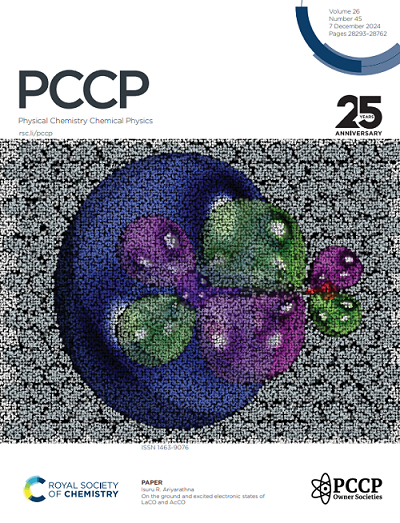Solvent-dimer-mediated clusters as a microscopic model of solution: IR spectroscopy and density functional theory of jet-cooled pyrrole-tetrahydrofuran clusters.
IF 2.9
3区 化学
Q3 CHEMISTRY, PHYSICAL
引用次数: 0
Abstract
A solvated cluster in a supersonic jet serves as a microscopic model of a bulk solution. Generally, a 1-1 cluster of an organic solute with a simple solvent molecule is considered the smallest solvated cluster. However, a bulk solution consists of a solute surrounded by multiple solvent molecules. Therefore, the smallest solvated cluster is practically a 1-2 cluster comprised of one solute and two solvents, allowing us to investigate intermolecular interactions not only between the solute and the solvent but also among the solvents themselves. In this study, we focus on solvent-dimer-mediated clusters of pyrrole (Py) and tetrahydrofuran (THF) dimers to elucidate the mechanism of micro-solvation. The solvation structures of Py-THF clusters are determined through a combination of IR cavity ringdown spectroscopy and density functional theory computations. The hydrogen-bonded structures of Py1-THF1, Py2-THF1, and Py1-THF2 are analyzed in terms of the geometric deformation of the THF backbone. Notably, we found that the geometric deformation of the solvent THF dimer in Py1-THF2 is significantly larger than that of the other solvent dimers. To discuss the relationship between the deformation of the solvent dimer and the solubility of the bulk solution, we introduced Hansen Solubility Parameters. Consequently, we concluded that the flexible solvation by a solvent dimer, due to its large deformation, correlates with higher solubility in a bulk solution. The concept of solvent-dimer-mediated clusters preliminarily provides new insights into connecting micro-solvation with macro-solutions.溶剂-二聚体介导的团簇作为溶液的微观模型:喷气冷却吡咯-四氢呋喃团簇的红外光谱和密度泛函理论。
超音速喷气机中的溶剂化团簇可作为散装溶液的微观模型。一般来说,有机溶质与简单溶剂分子的1-1簇被认为是最小的溶剂化簇。然而,散装溶液由溶质由多个溶剂分子包围而成。因此,最小的溶剂化簇实际上是由一个溶质和两个溶剂组成的1-2簇,这使得我们不仅可以研究溶质和溶剂之间的分子间相互作用,还可以研究溶剂本身之间的分子间相互作用。在本研究中,我们重点研究了吡咯(Py)和四氢呋喃(THF)二聚体的溶剂二聚体介导的簇,以阐明微溶剂化的机制。通过红外腔衰荡光谱和密度泛函理论计算,确定了Py-THF簇的溶剂化结构。根据THF主链的几何变形分析了Py1-THF1、Py2-THF1和Py1-THF2的氢键结构。值得注意的是,我们发现Py1-THF2中溶剂型THF二聚体的几何变形明显大于其他溶剂型二聚体。为了讨论溶剂二聚体的变形与体溶液溶解度之间的关系,我们引入了汉森溶解度参数。因此,我们得出结论,溶剂二聚体的柔性溶剂化,由于其大的变形,在散装溶液中具有较高的溶解度。溶剂-二聚体介导的簇的概念初步为连接微观溶剂化与宏观溶液提供了新的见解。
本文章由计算机程序翻译,如有差异,请以英文原文为准。
求助全文
约1分钟内获得全文
求助全文
来源期刊

Physical Chemistry Chemical Physics
化学-物理:原子、分子和化学物理
CiteScore
5.50
自引率
9.10%
发文量
2675
审稿时长
2.0 months
期刊介绍:
Physical Chemistry Chemical Physics (PCCP) is an international journal co-owned by 19 physical chemistry and physics societies from around the world. This journal publishes original, cutting-edge research in physical chemistry, chemical physics and biophysical chemistry. To be suitable for publication in PCCP, articles must include significant innovation and/or insight into physical chemistry; this is the most important criterion that reviewers and Editors will judge against when evaluating submissions.
The journal has a broad scope and welcomes contributions spanning experiment, theory, computation and data science. Topical coverage includes spectroscopy, dynamics, kinetics, statistical mechanics, thermodynamics, electrochemistry, catalysis, surface science, quantum mechanics, quantum computing and machine learning. Interdisciplinary research areas such as polymers and soft matter, materials, nanoscience, energy, surfaces/interfaces, and biophysical chemistry are welcomed if they demonstrate significant innovation and/or insight into physical chemistry. Joined experimental/theoretical studies are particularly appreciated when complementary and based on up-to-date approaches.
 求助内容:
求助内容: 应助结果提醒方式:
应助结果提醒方式:


